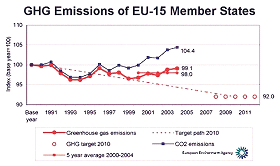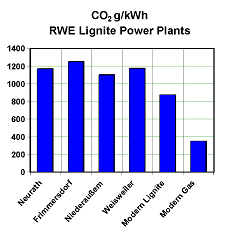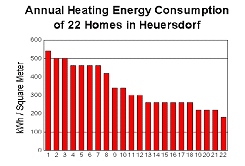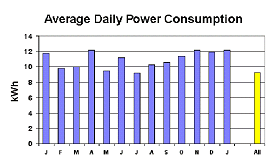|
1. The omnipresence of electronic computers for data processing and
2. The precipitous warming of the Earth’s atmosphere by the emission
of greenhouse gases (GHG).
Despite the global threat of climate change, the immense computing power available is not yet being strategically employed to control energy usage. The carbon dioxide (CO2) produced by fossil fuel combustion accounts for 59 percent of all manmade greenhouse gases.(1)
Dwindling Prospects for Fulfillment of the Kyoto Protocol
Since going into effect on February 16, 2005, the Kyoto Protocol to the United Nations Framework Convention on Climate Change requires 35 industrialized countries to reduce their greenhouse gas emissions by an average of 5.2 percent below 1990 levels by 2010/2012. The specific target of minus 8 percent that applies to the European Union may prove unattainable. Due to a 4.4 percent rise in carbon dioxide from fossil fuel usage, greenhouse gas emissions in the original 15 member states are diverging from a linear reduction path and have nearly returned to 1990 levels.(2) Reductions in the new member states cannot compensate for this result.
In evaluating the progress of greenhouse gas reductions, the European Environment Agency concluded in 2005 that only two of the EU-15 states – Sweden and the United Kingdom – could be expected to meet their Kyoto obligations. All others were projected to be “significantly above their commitments” using existing domestic policies and measures.(3)
The European Commission has nevertheless affirmed that the EU “must adopt the necessary domestic measures and take the lead internationally to ensure that global average temperature increases do not exceed pre-industrial levels by more than 2°C”.(4) Summer weather conditions are providing tangible confirmation of warming trends. The Netherlands Environmental Assessment Agency has determined that “climate change up to the present has already doubled the risk of heat waves”, which are responsible for “unusually large numbers of heat-related deaths”.(5)
To limit global temperature increases to 2°C with a likelihood of greater than 60 percent, it would be necessary to stabilize the concentration of CO2 equivalent greenhouse gases in the atmosphere at a volume of 450 parts per million (ppmv), or less.(6) Energy-efficient technologies have long been available to translate this objective into effective responses. In its 1987 report Our Common Future, the World Commission on Environment and Development (also known as the Brundtland Commission) called for a “safer and more sustainable energy future” using low-emission “renewables, energy-efficient industrial processes, transport vehicles, and energy-services”.(7) At the time, however, it was observed that “positive energy developments world-wide that made sense with oil at $25” during previous energy crises had become harder to justify after oil prices had declined.
The cost of a barrel of oil has since tripled to $60, but consumption is likewise on the rise. Although resource-efficient technologies have lowered the energy demand of individual applications, the number of applications has proliferated disproportionately. A growing world population is being availed of expansive living infrastructures, electrical appliances, and motorized transportation.
An extrapolation of current trends in aviation leads to the implausible prospect that all greenhouse gas emissions in Europe would be emanating from air travel by mid-century if the 450 ppmv requirement was simultaneously being observed.(8) Significant efficiency improvements are clearly necessary for maintaining energy services while emissions are being reduced.
The electrical power industry produces 40 percent of the energy-related carbon dioxide emissions worldwide – twice the greenhouse gases of either the transportation or industrial sector. In the absence of carbon restraints, older power stations are often kept in service to postpone investments in more efficient generation. This situation is exemplified by Germany’s largest electrical power producer, RWE AG, which has operated 18 lignite (brown coal) power plants at four locations for more than 40 years.(9) These outdated installations emit over three times as much carbon dioxide per kilowatt-hour as modern gas plants owing to an efficiency of only about 30 percent and the predominance of carbon in lignite fuel. With 127 million tons of CO2 annually (2002), RWE power stations constitute the greatest aggregate emissions source in Europe.(10) Lignite usage remains a major impediment to Kyoto compliance in Germany.

Emissions Trading as an Efficiency Incentive
CO2 emissions trading creates financial incentives for reducing greenhouse gases from industrial sources. The added expense of power generation using low-carbon fuels and renewable technologies effectively subsidizes improvements in demand-side energy efficiency.
Article 17 of the Kyoto Protocol allows countries to conduct emissions trading in fulfilling their greenhouse gas commitments under Article 3. In the European Union, an appropriate Emissions Trading Scheme (ETS) for carbon dioxide allowances has been implemented by Directive 2003/87/EC. Allowances are required for large stationary installations such as power and heat generators, oil refineries, and other major industrial facilities. Since the transportation and private sectors have been excluded, however, only about 40 percent of all greenhouse gas emissions in the EU are covered by the trading scheme.(11)
Demand Response for Carbon Emissions Reduction in North America
Although the United States has not ratified the Kyoto Protocol, the Northeast and Mid-Atlantic States, California, and Canada have announced their intention to establish emissions trading in the interest of climate protection. In marked contrast to Europe, a number of utility practices already include the customer into interactive response mechanisms that are effective in reducing fossil fuel consumption. Non-critical loads such as electrical heating and cooling equipment may be temporarily disconnected from the grid, or their usage may be shifted in time to more favorable rate periods. These demand response techniques reduce the need for backup generation and provide a corresponding degree of CO2 avoidance.
An adequate means of intercommunication is required to enable particular loads at each customer location to be switched manually or automatically in response to price changes or other data received from the utility company. Dual-tariff power meters that reduce the operating costs of electrical devices during off-peak hours require only a single exchange of information to prearrange the terms of delivery. Unpredictable conditions of demand, on the other hand, necessitate real-time communication between each power meter and the grid operator(12) for transmitting dynamic pricing signals and switching commands.
Confronting Climate Change with Computerized Power Meters
A network of home and office computers could hypothetically be employed to implement a demand response management system. Yet while every computer in use is electrically operated, the power required for continuous service might offset the energy savings achieved. In addition, the integrity of data received from an indeterminate network of computers requires independent verification. Even in that case, energy management capabilities would be restricted to computer owners, excluding other significant usage situations.
Alternatively, the existing power meter infrastructure can be upgraded to realize a computerized energy monitoring and control system. Adding an electronic microprocessor to each meter surpasses the capabilities of an arbitrary computer network in enhancing energy efficiency, for the following reasons:
1. Every household and business establishment is equipped with a power meter.
2. The electricity being measured enables continuous operation of the meter and auxiliary devices.
3. The meter microprocessor is available for measurement, computation, and communication.
4. Measurements are performed with unified accuracy, making independent data verification unnecessary.
5. Standardized design reduces hardware and maintenance costs.
If each meter is provided with a Universal Communications Interface (UCI), consumption data will be available not only to the grid operator, but likewise between utility customers themselves. Measurement analyses may then be compiled autonomously to evaluate usage trends and investigate cases of excessive demand. The required data transfers take place over the Internet. Using multifunctional metering capabilities, heating energy and water consumption can likewise be measured. The resulting comprehensive transparency of resource usage may reveal CO2 mitigation opportunities that would not otherwise have been apparent.
As a case in point, comparative measurements of 22 unrenovated homes in the German village of Heuersdorf (www.heuersdorf.de) in 1997 revealed high variations in heating usage for comparable levels of human comfort. Energy expenditures varying by up to a factor of three were determined, ranging from 180 to 540 kilowatt-hours per square meter and year (kWh/m2a).

Since one liter of heating oil supplies about 10 kWh of thermal energy, up to 50 liters of oil per square meter of floor space were being used annually in some dwellings, corresponding to an excessively high carbon dioxide emission level of 130 kg/m2a. The heating energy consumption of new and renovated buildings generally lies below 100 kWh/m2a, with corresponding yearly CO2 emissions of less than 30 kilograms per square meter. Highly insulated homes achieve values of 30 (“three-liter homes”) to 80 kWh/m2a, or less. These guidelines are now being employed by Heuersdorf in developing a low-energy model settlement at a new location, since the present village is being destroyed by the US-owned MIBRAG lignite mining company.
Starting on July 1, 2007, utility customers in Germany will be permitted by the Electricity and Gas Supply Act (Gesetz über die Elektrizitäts- und Gasversorgung) of 2005 to have their own power meters installed independently. Billing information may also be collected by qualified third parties. Metering service companies can thereupon establish energy efficiency networks for their customers. Any reduction of demand attained in this manner would constitute a CO2-free virtual power station that had supplanted conventional generating capacities.
Data-linked power meters used to monitor solar installations reveal differences in performance between individual photovoltaic installations. The regional contribution of load alleviation and CO2 emissions reduction may likewise be determined. Such a dedicated metering infrastructure would function as a distributed solar generator for diminishing grid loads during warm sunny days, when conventional power plants labor to satisfy peak demand under the limitations of their own cooling systems.
Demand-Side Efficiency Enhancements Using Information Feedback
Individual consumption may be evaluated periodically to reveal personal changes in usage. Whenever power meters are not equipped with a real-time communications interface, manual readings are employed. Power bills in the United States, Canada, Australia, and Scandinavia are generally issued monthly and may include a bar graph showing previous readings for comparing usage. Customers are motivated by this frequent feedback of information to remedy conditions of excessive consumption, thus exerting a demand-side influence on generating capacities and resultant CO2 emissions. A separate bar is often included to indicate the average demand of all customers in the same billing category for reference purposes.
The Centre for Sustainable Energy in the United Kingdom has determined that the monthly feedback of numerical and graphical data in the countries surveyed offers potential sustained energy savings of five to ten percent over the yearly billing practices that prevail in most of Europe.(13) Indications of excessive consumption will prompt the consumer to lower power costs by correcting wasteful behavior and by employing energy-efficient appliances. The Centre notes that the feedback of historical and comparative information is most effective “when it is immediate, prominent, accessible, and specific to the consumer”. It follows that the greatest resource savings can be achieved by supplanting periodic manual billing by the continuous measurement of power consumption and immediate data feedback to the customer.

The Energy Policy Act of 2005 recommends that customers be provided with “electricity price signals and the ability to respond to them”. According to the U.S. Department of Energy, alterations of normal consumption patterns may be expected “in response to changes in the price of electricity over time, or to incentive payments designed to induce lower electricity use at times of high wholesale market prices or when system reliability is jeopardized”.(14)
When data pickup is conducted only infrequently, interactive opportunities for peak-load remediation and short-term CO2 reduction are withheld from customers. The exclusion of time-sensitive rates can ultimately inhibit equitable and accurate billing.(15) Any diminishment of consumer influence counteracts the climate protection objectives of states such as California, where greenhouse gas emissions in the year 2020 are to be reduced to 1990 levels.(16)
Part 2 of this article will be published tomorrow on EnergyPulse
Footnotes:
1. Kevin Baumert, Jonathan Pershing, Climate Data. Insights and Observations (Arlington: Pew Center on Climate Change, December 2004), p. 5.
2. "EU greenhouse gas emissions increase for second year in a row" (Copenhagen: European Environment Agency, June 22, 2006).
3. Greenhouse gas emission trends and projections in Europe 2005 (Copenhagen: European Environment Agency, EIA Report 8/2005), p. 16.
4. Limiting Global Climate Change to 2 degrees Celsius. The way ahead for 2020 and beyond (Brussels: Commission of the European Communities, January 10, 2007), p. 2.
5. M.G.J. den Elzen, M. Meinshausen, Meeting the EU 2°C climate target: global and regional emission implications (Bilthoven: Netherlands Environmental Assessment Agency, Report 728001031/2005), p. 6.
6. Ibid., p. 2.
7. World Commission on Environment and Development, Our Common Future (Oxford: Oxford University Press, 1987), p. 201.
8. Decarbonising the UK. Energy for a Climate Conscious Future (Norwich: Tyndall Centre for Climate Change Research, 2005) p. 49.
9. Neue Braunkohletagebaue durch Kraftwerkserneuerung? (Düsseldorf: Parliament of North Rhine-Westfalia, DS 14/1040, January 11, 2006), p. 4.
10. Climate Change and the Power Industry (Paris: Enerpresse, November 2003), p. 11.
11. Greenhouse gas emission trends and projections in Europe 2006 (Copenhagen: European Environment Agency, EIA Report 9/2006), p. 32.
12. Intercommunication may be realized using either Powerline Communication (PLC) technologies, Wireless Wide Area Networks (WWAN), broadband cable networks, Internet via DSL, ISDN or analog telephone systems, or rudimentary dial-up services.
13. Simon Roberts, William Baker, Towards Effective Energy Information (Bristol: Centre for Sustainable Energy, July 2003), p. 4.
14. Benefits of Demand Response in Electricity Markets and Recommendations for Achieving Them (Washington: U.S. Department of Energy, February 2006), p. 6.
15. Veronica Irastorza, “New Metering Enables Simplified and More Efficient Rate Structures”, The Electricity Journal (December 2005).
16. Executive Order S-3-05 by the Governor of the State of California (Sacramento: Executive Department, State of California, June 1, 2005).
![]()
Copyright © 2002-2006, CyberTech, Inc. - All rights reserved.
